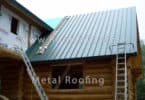Roofs can last for several decades, but eventually the sun, rain, wind, and ice take their toll. Residential property owners can use the guidelines below to estimate the cost of replacing a roof, whether it must occur now or can wait for a few years.
Basic Assumptions
The cost to replace a roof depends on several factors, including the size of the roof, the climate, the accessibility, local labor rates, and work that must be done. The National Roofing Contractors Association recommends looking at the annual cost of the roof per year instead of the total cost. This calculation is the total cost of the roofing job (materials and labor) divided by the life expectancy of the new roof.
Roofing professionals typically quote materials in squares, which is 100 square feet, or a 10′ by 10′ area. The average roof in the United States is 40′ by 60′, which is 2400 square feet or 24 squares. The examples given below are based on this figure.
Tear Off and Disposal
Before a roof can be replaced, the old roofing materials must be torn off or prepared for overlaying. Typical costs for tear-off are listed below:
1 layer: $90 – $140 per 100 square feet
2 layers: $110 – $160 per 100 square feet
3 layers: $120 – $170 per 100 square feet
Asphalt shingles fall at the lower end of the spectrum because they cost less to remove than wood shakes or tile. Roofing companies charge higher rates for roofs with high pitches, steep slopes of 25% or more, than for those with low pitches. In addition, a three-story house frequently costs more than a one-story ranch.
Homeowners who choose to overlay roofing materials, thereby putting one layer of shingles over another, can virtually eliminate tear-off costs. At the same time, many city codes limit the total number of layers that can exist on a roof. Professionals estimate that overlaying a roof can cut its life by as much as 20%, which means that the roof may cost less now but it will likely need to be replaced again sooner than anticipated.
Replacement
After the roof has been prepared, the materials are ready for replacement. During this period, the roofers may notice water damage or other problems that must be fixed before the new shingles or tiles can be installed. The homeowners also have a choice of protective underlayment, if the roof has been torn off to the decking.
Asphalt Shingles: $115 – $135 per 100 square feet
Slate: $120 – $140 per 100 square feet
Wood Shakes: $150 – $225 per 100 square feet
Clay Tiles: $170 – $255 per 100 square feet
Metal Roofing: $350 – $1100 per 100 square feet
Materials that offer longer warranties, more color options, and better decorative qualities are more expensive than basic roofing materials.
Ice and Water Protection Membrane (Ice Guard, Ice Shield): $66 per 100 square feet
Ice and water shields are used to prevent leaks and ice damage.
Remove and Replace Plywood Decking: $40 – $70 per sheet
Permits: $75 – $400
The cost of permits vary by state and city. Some agencies charge a flat fee while others base the permit cost on the value of the project.
Total Costs
Based on the prices listed above, a replacement roof with mid-grade materials can cost $10,000 and up. A 24 square roof with asphalt shingles and a single layer of tear-off can cost as little as $6,700, while the same roof with zinc or copper roofing can cost as much as $30,000. An example of a contractor’s roof estimate walk-through can be viewed here.
Homeowners can save on labor costs by installing the new roof themselves, but they must also factor in the quality of the job they can do and the time it will take. Professional roofers are trained in such areas as what materials to use for the local environment, how to install materials so they meet industry standards and building codes, where to dispose of waste properly, and how to work safely without damaging the roof system or injuring any of the workers.


